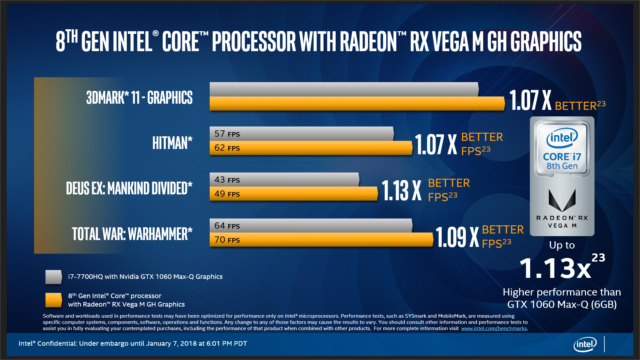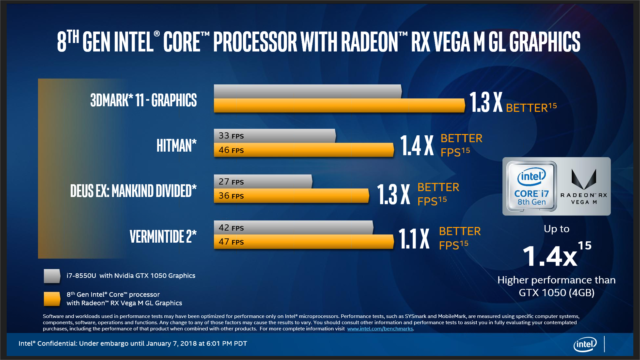One of the more surprising products announced last year was an Intel CPU with embedded AMD graphics, an unusual collaboration between two competitors. With the full specs now available, it's clear that the companies are taking aim at a common enemy: Nvidia.
The result is perhaps one of the most annoyingly named products we've seen in a while: the full branding is "8th generation Intel Core processor with Radeon RX Vega M Graphics." The CPU part is a Kaby Lake-R chip; these are the four-core, eight-thread versions of the 7th-generation chips. The CPUs are paired with either a Radeon RX Vega M GH or a Radeon RX Vega M GL GPU, which in turn is connected to 4GB of second-generation High Bandwidth Memory (HBM2).
In total, Intel is launching five variants of the Kaby Lake-G platform, with the inclusion of the AMD graphics indicated by the "G" at the end of the chip name. Four are i7 branded, the other i5. While clearly aimed at gamers first and foremost, one i7 part supports vPro management, suggesting that there may be some interest in corporate-oriented systems, too.
| i7-8809G | i7-8790G | i7-8706G | i7-8705G | i5-8305G |
|---|---|---|---|---|
| Boost CPU frequency/GHz | 4.2 | 4.1 | 3.8 | |
| Base CPU frequency/GHz | 3.1 | 2.8 | ||
| Cores/threads | 4/8 | |||
| Cache/MB | 8 | 6 | ||
| On-package GPU | Radeon RX Vega M GH | Radeon RX Vega M GL | ||
| Compute units | 24 | 20 | ||
| Stream processors | 1,536 | 1,280 | ||
| Texture units | 96 | 80 | ||
| Boost GPU frequency/MHz | 1,190 | 1,011 | ||
| Base GPU frequency/MHz | 1,063 | 931 | ||
| Discrete HBM2 memory/GB | 4 | |||
| HBM2 data rate/Gbps | 1.6 | 1.4 | ||
| Single precision floating point performance/TFLOPS | 3.7 | 2.6 | ||
| Memory bandwidth/GB/s | 204.8 | 179.2 | ||
| Overclockable CPU | Yes | |||
| Overclockable GPU | Yes | No | ||
| vPro management | No | Yes | No | |
| Package TDP/W | 100 | 65 |
The GPU is joined to the CPU with eight PCIe x3 lanes running within the package; another eight lanes from the CPU are available to other devices on the motherboard. The GPU's memory uses Intel's Embedded Multi-Die Interconnect Bridge (EMIB), a high-speed, short-range interconnect that uses small chunks of silicon embedded into the circuit board, rather than traditional copper traces.
Being Kaby Lake-R CPUs, the chips also include a GPU integrated into the CPU itself, the same Intel HD Graphics 630 as we see on other Kaby Lake-R parts. This GPU remains fully active and enabled, and, due to its lower power consumption, will be the preferred choice for standard desktop graphics and video playback.
Mutually beneficial
What's the point of it all? For Intel, these chips provide an upgrade to the H-series processors in previous generations. In prior generations, the low-power U-series parts were two core/four thread, and high-power H-series were four core/eight thread. With the eighth generation bumping the U-series up to four cores and eight threads, the question is what to do with the H-series. Adding more cores and threads would probably not be tremendously valuable to most mobile users.

Most H-series chips end up paired with discrete GPUs, however, so a faster GPU would have some benefit. Intel claims that moving the GPU onto the same package as the CPU reduces both the z-height of the motherboard (enabling systems that are a little thinner) and also reduces the motherboard area occupied by the GPU-CPU pair (enabling smaller motherboards and, hence, larger batteries). While Intel does have plans to build high-performance, discrete GPUs, the bundling of the AMD chip provides a stopgap solution.
For AMD, the Intel partnership opens the door to sales that might otherwise default to Nvidia. Until now, companies building gaming laptops have paired Intel processors with Nvidia graphics. While AMD would, of course, prefer a pure AMD solution, the company doesn't yet have any high-power mobile CPUs in the same ballpark as the Intel H-series parts. As such, these G-series chips don't represent a lost CPU sale, but, rather, a gained GPU sale.
Potent performance
All this only matters if the performance is up to scratch. Thus far the only benchmarks we have are from Intel, so some skepticism is warranted—but the Kaby Lake-G with the lower-spec GL GPU appears to be around 30 percent faster than the Nvidia GTX 1050, and the higher-spec GH GPU is even slightly ahead of the 1060 GTX MaxQ chip (the lower power variant of the 1060 GTX).

The big wrinkle is that Intel is using U-series processors in the Nvidia systems. While those U-series processors are identical to the ones used in Kaby Lake-G, they're subject to a standard 15W TDP (though can, depending on system configuration, go as high as 25W). The CPU in the new chips is subject to an overall TDP of 65W or 100W; some of the performance gains may very well come from the ability to push the CPU harder than the discrete GPU.
The specific details of the power handling of these parts remains murky. The package manages power distribution between CPU and GPU, and Intel makes vague claims that the power management of the combined package is better than with discrete graphics but didn't talk about precisely how those power budgets were distributed. The biggest change is that power distribution is now Intel's problem, rather than the OEM's: if the package is at its full power and more CPU resources are needed, it's now up to the Intel package to decide whether to cut the GPU power and boost the CPU or not.
-
This pits a GH part against an older CPU/GPU pair; the advantage is rather more clearcut. Intel -
This pits a GL part against an older CPU/GPU pair; the advantage is rather more clearcut. Intel
The other big detail is price and availability. Neither is forthcoming just yet. This week at CES we'll see at least two designs from two major OEMs that use Kaby Lake-G.
-
The NUC8i7HVK. What a name. Intel -
No shortage of ports on the back panel, including two Thunderbolt 3 and two gigabit Ethernet. Intel -
Quite a few ports up front, too. -
The LEDs illuminating the skull can be turned off.
Intel is also producing two NUC systems, one with the i7-8890G, the other with the i7-8705G. These little PCs are decked out with Thunderbolt 3, a pair of gigabit Ethernet ports, 802.11ac; just add your own RAM and storage and you're good to go.
[contf] [contfnew] 
Ars Technica
[contfnewc] [contfnewc]























































